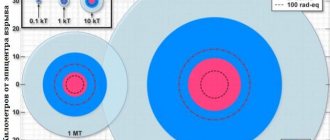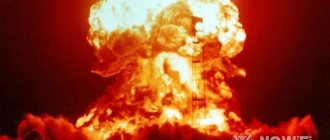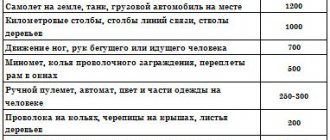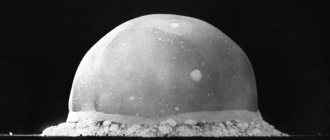Let's say a nuclear war breaks out. It is logical to assume that, among others, airborne nuclear explosions will be carried out in order to cause maximum damage through an electromagnetic pulse. What exactly will go wrong among the civilian population and how much does it depend on the distance to the epicenter? I have read diametrically opposed judgments from “everything and everything will burn” to “nothing special will happen.”
I propose to collectively look into this issue. It seems that the most interesting is whether the following objects will withstand the attack: - power lines - intra-house cable networks - batteries of various types - semiconductor elements - power supplies, inverters - ignition systems in cars - internal combustion engines, generators It seems to me that the answer to the question First of all, it depends on what voltage and current will arise in the circuits of these objects.
Part I. Initial data
As far as I know, humanity has carried out only two experiments to determine the damage caused by EMP. In 1962, the United States detonated a 1.4-megaton bomb in the Pacific Ocean.
Among the known effects, radio communications were interrupted, wired telephone communications failed, security alarm systems went off at a distance of 1,300 km from the epicenter, street lighting networks and car ignition systems failed.
Regarding the last point, it is not clear why. As can be seen from the picture, the strength of the e/magnetic field gradually decreased with distance, but over enormous distances!
The second experiment was carried out by the USSR a little later in the same year (300 kt).
Of the few data that exist, the following are interesting: - the field strength with distance for some reason increased from 5 to 20 kV. - a telephone line and an underground power line burned out, and data was given on the resulting current strength and line length - 570 km and 2500A
Other pictures and a lot of text in English - glasstone.blogspot.ru/2006/03/emp-radiation-from-nuclear-space.html
If you solve the problem completely stupidly, then there is a formula: field strength = voltage / conductor length. From here, knowing the voltage (see pictures above) and the length of specific conductors, it would be possible to calculate the voltage. But some millions of volts arise. Probably, the direction of the conductor should coincide with the direction of the field lines - which does not happen in reality.
Then, if you approach it from the other side, you can take data from the Soviet experiment. A field strength of 15,000 V/m gives a current of 4.4 milliamps (2500/570000) in each additional meter of conductor. This is quite small. Let's say, on a transformer loop - a country house about 2000 meters long will give only 9 amperes - like turning on a kettle, nothing.
On the other hand, the work of Ph.D. is floating around the network. Colonel D. Figurovsky, in which he notes (https://forums.airbase.ru/2013/10/t27117—elektromagnitnyj-impuls-yadernogo-vzryva.6365.html): “It has been theoretically calculated and experimentally confirmed that the currents induced EMI in above-ground and buried power cables with a length of hundreds and thousands of kilometers can reach thousands of amperes, and the voltages arising in open circuits of such cables can reach millions of volts. In antenna inputs, the length of which does not exceed tens of meters, the EMI-induced currents can be several hundred amperes. EMR penetrating directly through elements of structures made of dielectric materials (unshielded walls, windows, doors, etc.) can induce currents of tens of amperes in internal electrical wiring. Currents induced in the aircraft’s skin and the ultra-long-wave communication antenna can be up to 1000A, which leads to the emergence of currents in the internal on-board network with a force of 1 - 10 A.”
Those. for power lines maximum 10A per 1 km (10 mA per 1 m) (similar to 4.4 mA from the experiment) For antennas: maximum 10A per 1 m For internal wiring (the length is unclear here): about 0.1 A - 1 A per 1 m
As you can see, the difference is orders of magnitude, which complicates further research
II. Interim conclusions
1. Either at the epicenter of the explosion or at a distance of hundreds of kilometers, the voltage value differs only 2-3 times. One explosion over Moscow is enough to cover the entire European part of Russia with an effect. Therefore, there is no point in hiding electronics in a country house away from the city. 2. Power lines are galvanically isolated from local lines, from which country houses are powered using a transformer. Therefore, if high-voltage power lines burn out, the locals are unlikely to be in any danger - their length is short. In addition, recently reconstructed ones are protected by lightning arresters, which are capable of neutralizing a voltage surge of up to several thousand volts. 3. Even if currents of 10-100A arise in the wiring in houses, this will not lead to damage to the wiring itself. In addition, the circuit breakers will operate. But some things, of course, can burn out. Let's say, if you have a 16A circuit breaker on the line, only a 100-watt light bulb is turned on, and as a result of the EMP another 10A flows through it, then it will burn out. With other household appliances connected to the network, it is impossible to say for sure. Powerful consumers protected by a small-rated circuit breaker will not burn out (for example, a working 2000-watt grinder or a kettle under a 16A circuit breaker). 4. Walkie-talkies with antennas can burn out regardless of whether the batteries are removed or not.
Part III. Batteries, semiconductors, automobiles
With these things the uncertainty is higher.
1. Batteries not connected to the network will remain fine. Those that are included in the network can receive tens of amperes in the home network, as a result of which they will overheat and deteriorate (explode?) 2. In electric motors, generators, power supplies (and everything else containing transformers, chokes, inductors on magnetic cores) are possible temporary problems - up to 30 minutes (https://gochs.info/p0967.htm) 3. I’m not an expert in semiconductors at all, but I’ll quote: “Irreversible problems can be the result of either thermal overload or electrical overvoltage. As a result of thermal overload, the following damage to equipment elements may occur: - burnout of safety inserts and resistors; — destruction of the plates of ceramic capacitors and electrodes of low-power spark gaps; — sintering of low-current relay contacts; — wire breakage at soldering (welding) points; — melting of current-carrying and resistive layers of semiconductor devices. The consequence of electrical overvoltage can be electrical breakdowns, which are typical for capacitors, adapter plug connectors, relay contact groups, and cable insulation.”
In general, if a device containing semiconductors was plugged into the network, and the automatic protection did not work, then it seems that everything will burn out. Including chargers for mobile phones, power supplies, inverters. On the other hand, if all this was not plugged into an outlet, then it should remain in good condition.
4. Cars. It's unclear here. On the one hand, modern cars contain electronics. But the length of the wires in the car is not that long, and besides, there is some kind of screen. On the other hand, in Hawaii, cars did not start after an EMP, although at that time there could not be any electronics in them. The question remains open: what exactly went wrong there?
General conclusion
1. The central power supply will be interrupted for a very long period of time 2. Internal networks and even village networks can be used by powering them from generators 3. If you want to save something (except for walkie-talkies with antennas), you do not need to build a metal box, just turn off the power.
ELECTROMAGNETIC PULSE OF NUCLEAR EXPLOSION AND PROTECTION AGAINST IT
The damaging effect of an electromagnetic pulse (EMP) is caused by the occurrence of induced voltages and currents in various conductors. The effect of EMR manifests itself primarily in relation to electrical and radio-electronic equipment. The most vulnerable are communication, signaling and control lines. In this case, insulation breakdown, damage to transformers, damage to semiconductor devices, etc. may occur. HISTORY OF THE ISSUE AND THE CURRENT STATE OF KNOWLEDGE IN THE FIELD OF EMC
In order to understand the complexity of the problems of the EMP threat and measures to protect against it, it is necessary to briefly consider the history of the study of this physical phenomenon and the current state of knowledge in this area.
The fact that a nuclear explosion would necessarily be accompanied by electromagnetic radiation was clear to theoretical physicists even before the first test of a nuclear device in 1945. During nuclear explosions in the atmosphere and outer space carried out in the late 50s and early 60s, the presence of EMR was recorded experimentally. However, the quantitative characteristics of the pulse were measured insufficiently, firstly, because there was no control and measuring equipment capable of recording extremely powerful electromagnetic radiation, existing for an extremely short time (millionths of a second), secondly, because in those years in radio-electronic equipment only electro-vacuum devices were used, which were little susceptible to the effects of EMR, which reduced interest in its study.
The creation of semiconductor devices, and then integrated circuits, especially digital devices based on them, and the widespread introduction of means into electronic military equipment forced military specialists to evaluate the EMP threat differently. Since 1970, issues of protecting weapons and military equipment from EMP began to be considered by the Ministry of Defense as having the highest priority.
The mechanism for generating EMR is as follows. During a nuclear explosion, gamma and X-ray radiation are generated and a flux of neutrons is formed. Gamma radiation, interacting with molecules of atmospheric gases, knocks out so-called Compton electrons from them. If the explosion is carried out at an altitude of 20-40 km, then these electrons are captured by the Earth's magnetic field and, rotating relative to the lines of force of this field, create currents that generate EMR. In this case, the EMR field is coherently summed towards the earth’s surface, i.e. The Earth's magnetic field plays a role similar to a phased array antenna. As a result of this, the field strength sharply increases, and consequently the amplitude of the EMR in the areas south and north of the epicenter of the explosion. The duration of this process from the moment of explosion is from 1 - 3 to 100 ns.
At the next stage, lasting approximately from 1 μs to 1 s, EMR is created by Compton electrons knocked out of molecules by repeatedly reflected gamma radiation and due to the inelastic collision of these electrons with the flow of neutrons emitted during the explosion.
In this case, the EMR intensity turns out to be approximately three orders of magnitude lower than at the first stage.
At the final stage, which takes a period of time after the explosion from 1 s to several minutes, EMR is generated by the magnetohydrodynamic effect generated by disturbances of the Earth's magnetic field by the conductive fireball of the explosion. The intensity of EMR at this stage is very low and amounts to several tens of volts per kilometer.
The greatest danger for radio-electronic equipment is the first stage of EMR generation, at which, in accordance with the law of electromagnetic induction, due to the extremely rapid increase in the pulse amplitude (the maximum is reached 3 - 5 ns after the explosion), the induced voltage can reach tens of kilovolts per meter at the level of the earth's surface , gradually decreasing as it moves away from the epicenter of the explosion.
The amplitude of the voltage induced by EMR in conductors is proportional to the length of the conductor located in its field and depends on its orientation relative to the electric field strength vector. Thus, the EMR field strength in high-voltage power lines can reach 50 kV/m, which will lead to the appearance of currents of up to 12 thousand amperes in them.
EMPs are also generated during other types of nuclear explosions - air and ground. It has been theoretically established that in these cases its intensity depends on the degree of asymmetry of the spatial parameters of the explosion. Therefore, an air explosion is the least effective from the point of view of generating EMP. The EMP of a ground explosion will have a high intensity, but it quickly decreases as it moves away from the epicenter.
Since low-current circuits and electronic devices normally operate at voltages of several volts and currents up to several tens of milliamps, for their absolutely reliable protection from EMI it is necessary to ensure a reduction in the magnitude of currents and voltages in cables by up to six orders of magnitude.
POSSIBLE WAYS TO SOLUTION THE PROBLEM OF EMP PROTECTION
The ideal protection against EMR would be to completely cover the room in which the radio-electronic equipment is located with a metal screen. At the same time, it is clear that it is practically impossible to ensure such protection in some cases, because For equipment to operate, it is often necessary to provide electrical communication with external devices. Therefore, less reliable means of protection are used, such as conductive mesh or film coverings for windows, honeycomb metal structures for air intakes and vents, and contact spring gaskets placed around the perimeter of doors and hatches.
A more complex technical problem is considered to be protection against the penetration of EMR into equipment through various cable entries. A radical solution to this problem could be the transition from electrical communication networks to fiber-optic networks that are practically not affected by EMR. However, replacing semiconductor devices in the entire range of functions they perform with electro-optical devices is possible only in the distant future. Therefore, at present, filters, including fiber filters, as well as spark gaps, metal oxide varistors and high-speed Zener diodes, are most widely used as means of protecting cable entries.
All these means have both advantages and disadvantages. Thus, capacitive-inductive filters are quite effective for protection against low-intensity EMI, and fiber filters protect in a relatively narrow range of ultrahigh frequencies. Spark gaps have significant inertia and are mainly suitable for protection against overloads arising under the influence of voltages and currents induced in the casing aircraft, equipment casing and cable sheathing.
Metal oxide varistors are semiconductor devices that sharply increase their conductivity at high voltage. However, when using these devices as means of protection against EMI, one should take into account their insufficient performance and deterioration of characteristics under repeated exposure to loads. These disadvantages are absent in high-speed Zener diodes, the operation of which is based on a sharp avalanche-like change in resistance from a relatively high value to almost zero when the voltage applied to them exceeds a certain threshold value. In addition, unlike varistors, the characteristics of Zener diodes do not deteriorate after repeated exposure to high voltages and mode switching.
The most rational approach to designing means of protection against EMI of cable glands is to create such connectors, the design of which includes special measures to ensure the formation of filter elements and the installation of built-in Zener diodes. This solution helps to obtain very small values of capacitance and inductance, which is necessary to provide protection against pulses that have a short duration and, therefore, a powerful high-frequency component. The use of connectors of a similar design will solve the problem of limiting the weight and size characteristics of the protection device.
A Faraday cage is a device for shielding equipment from external electromagnetic fields. Usually it is a grounded cage made of highly conductive material.
The principle of operation of a Faraday cage is very simple - when a closed electrically conductive shell enters an electric field, the free electrons of the shell begin to move under the influence of this field. As a result, the opposite sides of the cell acquire charges, the field of which compensates for the external field.
A Faraday cage only protects against electric fields. The static magnetic field will penetrate inside. A changing electric field creates a changing magnetic field, which in turn creates a changing electric field. Therefore, if a changing electric field is blocked using a Faraday cage, then a changing magnetic field will not be generated either.
However, in the high-frequency region, the action of such a screen is based on the reflection of electromagnetic waves from the surface of the screen and the attenuation of high-frequency energy in its thickness due to thermal losses due to eddy currents.
The ability of a Faraday cage to shield electromagnetic radiation is determined by: the thickness of the material from which it is made; depth of surface effect; the ratio of the size of the openings in it to the wavelength of external radiation. To shield a cable, it is necessary to create a Faraday cage with a highly conductive surface along the entire length of the shielded conductors. In order for a Faraday cage to work effectively, the size of the grid cell must be significantly smaller than the wavelength of the radiation from which protection is required. The operating principle of the device is based on the redistribution of electrons in a conductor under the influence of an electromagnetic field.
Electromagnetic radiation
Electromagnetic pulse.
Nuclear explosions in the atmosphere and in higher layers lead to the emergence of powerful electromagnetic fields with wavelengths from 1 to 1000 m or more. Due to their short-term existence, these fields are usually called an electromagnetic pulse (EMP).
The damaging effect of EMR is caused by the occurrence of voltages and currents in conductors of various lengths located in the air, ground, on equipment and other objects. The main reason for the generation of EMR lasting less than 1 second. They consider the interaction of gamma quanta and neutrons with gas in the front of the shock wave and around it. The occurrence of asymmetry in the distribution of spatial electric charges associated with the peculiarities of the propagation of gamma radiation and the formation of electrons is also important.
In a ground or low air explosion, gamma quanta emitted from the zone of nuclear reactions knock out fast electrons from air atoms, which fly in the direction of the gamma quanta at a speed close to the speed of light, and positive ions (atomic residues) remain in place .
As a result of this separation of electric charges in space, elementary and resulting electric and magnetic fields of EMR are formed. In ground and low air explosions, the damaging effects of EMP are observed at a distance of about several kilometers from the epicenter of the explosion.
During a high-altitude nuclear explosion (H> 10 km), EMR fields may arise in the explosion zone and at altitudes of 20–40 km. from the surface of the earth. EMR in the explosion zone occurs due to fast neutrons, which are formed as a result of the interaction of gamma quanta of a nuclear explosion with the material of the ammunition shell and X-ray radiation with atoms of the surrounding rarefied air space. Gamma radiation emitted from the explosion zone towards the earth's surface begins to be absorbed in denser layers of the atmosphere at altitudes of 20 - 40 km, knocking out fast electrons from air atoms. As a result of the separation and movement of positive and negative charges in this area and in the explosion zone, as well as the interaction of charges with the geomagnetic field of the Earth, electromagnetic radiation arises, which reaches the surface of the earth in a zone with a radius of up to several hundred kilometers.
Electric and magnetic fields EMR as a damaging factor is characterized by field strength. The shape of an EMR pulse is a rapidly decaying oscillatory process with several quasi-half cycles. The strength of the electric and magnetic fields depends on the power, height of the explosion, distance from the center of the explosion and the properties of the environment.
Damaging effect of EMR.
It manifests itself primarily in relation to radio-electronic and electrical equipment. Under the influence of EMR, electrical currents and voltages are induced in the equipment, which lead to its failure. Communication, signaling and control lines are most susceptible to EMR. If nuclear explosions occur near long-distance power supply and communication lines, then the voltages induced in them can spread along the wires for many kilometers and cause damage to equipment and injury to people located at a safe distance from other damaging factors of a nuclear explosion.
A high-altitude explosion can interfere with communications over very large areas
When the magnitude of the EMR is insufficient to damage devices or individual parts, it is possible that protective equipment (fuse links, lightning arresters) will operate and disrupt the operation of the lines.











